
Clexane
Ask a doctor about a prescription for Clexane

How to use Clexane
Leaflet accompanying the packaging: patient information
Clexane, 2000 IU (20 mg)/0.2 ml, solution for injection in pre-filled syringes
Clexane, 4000 IU (40 mg)/0.4 ml, solution for injection in pre-filled syringes
Clexane, 6000 IU (60 mg)/0.6 ml, solution for injection in pre-filled syringes
Clexane, 8000 IU (80 mg)/0.8 ml, solution for injection in pre-filled syringes
Clexane, 10,000 IU (100 mg)/1 ml, solution for injection in pre-filled syringes
Enoxaparin sodium
Read the leaflet carefully before using the medicine, as it contains important information for the patient.
- Keep this leaflet, you may need to read it again.
- If you have any further questions, ask your doctor, pharmacist, or nurse.
- This medicine has been prescribed for you only. Do not pass it on to others. It may harm them, even if their symptoms are the same as yours.
- If you experience any side effects, including those not listed in this leaflet, tell your doctor or pharmacist. See section 4.
Table of contents of the leaflet
- 1. What is Clexane and what is it used for
- 2. Important information before using Clexane
- 3. How to use Clexane
- 4. Possible side effects
- 5. How to store Clexane
- 6. Contents of the pack and other information
1. What is Clexane and what is it used for
Clexane contains the active substance enoxaparin sodium. It belongs to a group of medicines called low molecular weight heparins or LMWHs.
How Clexane works
Clexane works in two ways:
- 1) It prevents the growth of existing blood clots. This helps the body to dissolve existing blood clots, making them no longer harmful.
- 2) It prevents the formation of new blood clots in the patient's blood.
What Clexane is used for
Clexane can be used for:
- Treating blood clots that are already present in the patient's blood.
- Preventing the formation of blood clots in the patient's blood in the following cases: before and after surgery, during a short-term illness when the patient will not be able to move for a period, in patients who have developed blood clots in the circulating blood due to cancer, to further prevent the formation of new blood clots
- Preventing the formation of blood clots in unstable angina (when insufficient blood is supplied to the heart muscle) or after a heart attack
- Preventing the formation of clots in dialysis tubes (used in people with severe kidney function disorders).
2. Important information before using Clexane
Do not use Clexane if:
- the patient is allergic to: enoxaparin sodium or any of the other ingredients of this medicine (listed in section 6) heparin or other low molecular weight heparins, such as nadroparin, tinzaparin, or dalteparin. Symptoms of an allergic reaction may include: rash, difficulty breathing or swallowing, swelling of the face, lips, tongue, mouth, throat, or eyes.
- the patient has had a reaction to heparin that caused a significant decrease in the number of blood cells responsible for blood clotting (platelets) in the last 100 days.
- there are antibodies against enoxaparin in the patient's blood.
- the patient has severe bleeding or a medical condition associated with an increased risk of bleeding, such as: stomach ulcers, recent brain or eye surgery, or recent hemorrhagic stroke.
- the patient is using Clexane to treat blood clots and a lumbar puncture or spinal or epidural anesthesia is planned within 24 hours: do not use Clexane in these patients. If in doubt, consult your doctor or pharmacist before starting Clexane.
Warnings and precautions
Clexane should not be exchanged with other low molecular weight heparins such as nadroparin, tinzaparin, or dalteparin. This is because they are not exactly the same, differ in activity, and have different instructions for use.
Before starting Clexane, discuss with your doctor or pharmacist if:
- the patient has ever had a reaction to heparin that caused a large decrease in the number of blood cells responsible for blood clotting (platelets)
- the patient has a heart valve replacement
- the patient has endocarditis (infection of the membrane lining the heart from the inside)
- the patient has stomach ulcers
- the patient has recently had a brain stroke
- the patient has high blood pressure
- the patient has diabetes or has problems with blood vessels in the eyes caused by diabetes (so-called diabetic retinopathy)
- the patient has recently had eye or brain surgery
- the patient is elderly (over 65 years), especially if they are over 75 years old
- the patient has kidney disease
- the patient has liver disease
- the patient is underweight or overweight
- the patient has an increased level of potassium in the blood (which can be checked with a blood test)
- the patient is currently taking medications that may cause bleeding (see section 2 "Clexane and other medicines")
- the patient has spinal problems or has had spinal surgery. If any of the above situations apply to the patient or the patient has doubts, consult a doctor or pharmacist before starting Clexane.
In the case of patients taking doses higher than 210 mg/day, this medicine contains more than 24 mg of sodium (the main component of table salt) in each dose. This corresponds to 1.2% of the maximum recommended daily intake of sodium in the diet for adults.
Tests and monitoring
Before starting this medicine and periodically during its use, the patient may undergo a blood test; its purpose is to check the number of platelets responsible for blood clotting and potassium in the patient's blood.
Use in children and adolescents
The safety and efficacy of Clexane have not been evaluated in children and adolescents.
Clexane and other medicines
Tell your doctor or pharmacist about all medicines you are taking now or recently, and about medicines you plan to take.
- warfarin - a medicine used to thin the blood
- aspirin (also known as acetylsalicylic acid or ASA), clopidogrel, or other medicines used to prevent blood clots (see section 3 "Change of anticoagulant medicine")
- dextran injections - used as a blood substitute
- ibuprofen, diclofenac, ketorolac, or other non-steroidal anti-inflammatory medicines used to treat pain and swelling in arthritis and other conditions
- prednisolone, dexamethasone, or other medicines used to treat asthma, rheumatoid arthritis, and other conditions
- medicines that increase potassium levels in the blood, such as potassium salts, diuretics, or certain heart medicines
Surgical procedures and anesthetics
If the patient is scheduled for a lumbar puncture or surgery under spinal or epidural anesthesia, inform the doctor that the patient is taking Clexane.
Pregnancy and breastfeeding
If the patient is pregnant or breastfeeding, thinks she may be pregnant, or plans to have a child, she should consult a doctor or pharmacist before taking this medicine.
In pregnant women with a mechanical heart valve, there may be an increased risk of blood clots. The doctor should discuss this with the patient.
Women who are breastfeeding or plan to breastfeed should consult a doctor before starting this medicine.
Driving and using machines
Clexane does not affect the ability to drive and use machines.
It is recommended that the doctor documents the trade name and batch number of the product used.
3. How to use Clexane
This medicine should always be used as directed by your doctor or pharmacist. If you are unsure, consult your doctor or pharmacist.
Taking the medicine
- Clexane will usually be administered to the patient by a doctor or nurse. This is because it requires injections.
- Clexane is usually administered subcutaneously.
- Clexane may be administered intravenously after certain types of heart attack or after surgery.
- Clexane may be introduced into the dialysis tube returning blood from the body (into the so-called arterial line) at the beginning of the dialysis session.
- Clexane must not be administered intramuscularly.
Dose
- The doctor will decide what dose of Clexane the patient should take. This depends on the reason for using the medicine.
- In the case of kidney disease, the patient may receive a lower dose of Clexane.
- 1) Treatment of blood clots present in the patient's blood
- The usual dose is 150 IU (1.5 mg) per kilogram of body weight once daily or 100 IU (1 mg) per kilogram of body weight twice daily.
- The doctor will decide how long the patient should receive Clexane.
- 2) Prevention of blood clot formation in the patient's blood during surgical procedures or during periods of limited mobility due to illness
- The dose depends on the patient's risk of developing a blood clot. The patient will receive Clexane at a dose of 2000 IU (20 mg) or 4000 IU (40 mg) daily.
- In the case of planned surgery, the first injection is usually performed 2 hours or 12 hours before the procedure.
- If the patient has limited mobility due to illness, they usually receive Clexane at a dose of 4000 IU (40 mg) daily.
- The doctor will decide how long the patient should receive Clexane.
- 3) Prevention of blood clot formation in patients with unstable angina or after a heart attack
- Clexane can be used in two different types of heart attacks.
- The dose of Clexane will depend on the patient's age and the type of heart attack that occurred.
Non-ST-segment elevation myocardial infarction (NSTEMI):
- The usual dose is 100 IU (1 mg) per kilogram of body weight every 12 hours.
- The doctor will usually recommend that the patient also take aspirin (acetylsalicylic acid).
- The doctor will decide how long the patient should receive Clexane.
ST-segment elevation myocardial infarction (STEMI) in patients under 75 years of age:
- The initial dose of Clexane is 3000 IU (30 mg) administered intravenously.
- Clexane is also administered subcutaneously. The usual dose is 100 IU (1 mg) per kilogram of body weight every 12 hours.
- The doctor will usually recommend that the patient also take aspirin (acetylsalicylic acid).
- The doctor will decide how long the patient should receive Clexane.
STEMI in patients 75 years of age or older:
- The usual dose is 75 IU (0.75 mg) per kilogram of body weight every 12 hours.
- The maximum amount of Clexane in the first two doses is 7500 IU (75 mg).
- The doctor will decide how long the patient should receive Clexane.
Patients undergoing percutaneous coronary intervention (PCI):
- Depending on when the last dose of Clexane was administered, the doctor may decide to administer an additional dose of Clexane before the PCI procedure. The medicine will be administered intravenously.
- 4) Prevention of blood clot formation in dialysis tubes
- The usual dose is 100 IU (1 mg) per kilogram of body weight.
- Clexane is injected into the dialysis tube returning blood from the body (into the so-called arterial line) at the beginning of the dialysis session. This amount usually lasts for a 4-hour dialysis session. However, if necessary, the doctor may administer an additional dose of 50 IU to 100 IU (0.5 to 1 mg) per kilogram of body weight.
Self-administration of Clexane.
If the patient is able to self-administer Clexane, the doctor or nurse will demonstrate how to do it. Do not attempt to self-administer if the patient has not been trained on how to do it. If in doubt, consult a doctor or nurse immediately. Proper subcutaneous injection (so-called "subcutaneous injection") can reduce pain and bruising at the injection site.
Before self-administering Clexane
- Prepare all necessary items: syringe, alcohol swab, soap and water, and a container for medical waste.
- Check the expiration date on the packaging. Do not use the medicine after the expiration date.
- Check if the syringe is damaged and if the liquid is clear. If not, use another syringe.
- Make sure what dose is to be administered.
- Examine the abdomen to check if the last injection has caused redness, skin discoloration, swelling, discharge, or if it is still painful. If so, consult a doctor or nurse.
Instructions for self-administering Clexane: (Instructions for pre-filled syringes without a safety system)
Preparing the injection site
- 1) Choose an injection site on the right or left side of the abdomen. The injection site should be at least 5 cm away from the navel towards the sides.
- Do not inject within 5 cm of the navel or around existing scars or bruises.
- Change the injection sites between the left and right side of the abdomen, depending on the location of the previous injection.
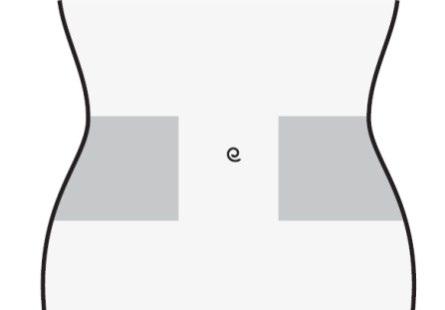
- 2) Wash your hands. Clean the injection site with an alcohol swab or soap and water.
- 3) Sit or lie down in a comfortable position, so that you are relaxed. Make sure the injection site is in your line of sight. A chair, couch, or bed with pillows for support will be suitable.
Dose selection
- 1) Carefully remove the needle cap from the syringe. Discard the cap.
- Do not press the plunger before injecting to remove air bubbles. This may reduce the administered dose.
- After removing the cap, do not touch the needle. This will ensure the sterility of the needle.
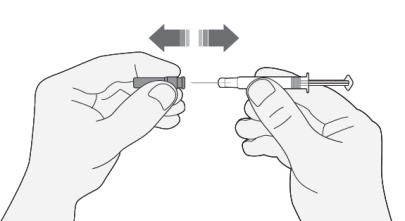
- 2) If the amount of medicine in the syringe is consistent with the prescribed dose, there is no need to adjust the dose. You can now perform the injection.
- 3) If the dose depends on body weight, it may be necessary to adjust the dose in the syringe according to the prescribed dose. In this case, remove excess medicine by holding the syringe upside down (to maintain air bubbles in the syringe) and discard excess medicine into a container.
- 4) A drop may appear at the end of the needle. In this case, remove the drop before injecting by tapping the syringe with the needle facing down. You can now perform the injection.
Injection
- 1) Hold the syringe in the hand you write with (like a pencil). With your other hand, gently grasp the cleaned abdominal skin with your index finger and thumb, creating a skin fold between your fingers.
- Make sure to maintain the skin fold during the injection.
- 2) Hold the syringe with the needle facing down (vertically at a 90-degree angle). Insert the entire length of the needle into the skin fold.
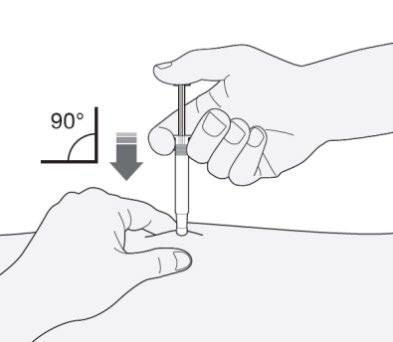
- 3) Press the plunger with your thumb. This will introduce the medicine into the abdominal fatty tissue. Inject the entire amount of medicine from the syringe.
- 4) Remove the needle from the injection site, pulling it straight out. Keep the needle away from yourself and others. Now you can release the skin fold.

After the injection
- 1) To avoid bruising, do not rub the injection site after the injection.
- 2) Dispose of the used syringe in a container for medical waste. Close the container and store it in a place that is not visible and inaccessible to children. If the container is full, dispose of it according to the doctor's or pharmacist's instructions.
Dispose of any unused medicines or waste in accordance with local regulations.
(Instructions for pre-filled syringes with a safety system of the ERIS type)
Preparing the injection site
- 1) Choose an injection site on the right or left side of the abdomen. The injection site should be at least 5 cm away from the navel towards the sides.
- Do not inject within 5 cm of the navel or around existing scars or bruises.
- Change the injection sites between the left and right side of the abdomen, depending on the location of the previous injection.
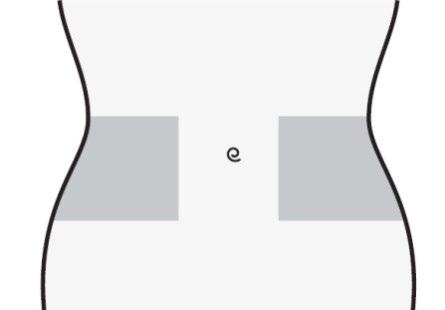
- 2) Wash your hands. Clean the injection site with an alcohol swab or soap and water.
- 3) Sit or lie down in a comfortable position, so that you are relaxed. Make sure the injection site is in your line of sight. A chair, couch, or bed with pillows for support will be suitable.
Dose selection
- 1) Carefully remove the needle cap from the syringe. Discard the cap.
- Do not press the plunger before injecting to remove air bubbles. This may reduce the administered dose.
- After removing the cap, do not touch the needle. This will ensure the sterility of the needle.
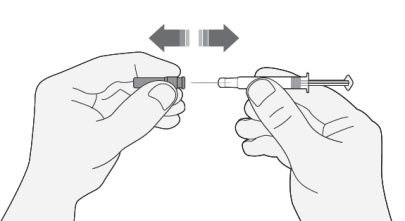
- 2) If the amount of medicine in the syringe is consistent with the prescribed dose, there is no need to adjust the dose. You can now perform the injection.
- 3) If the dose depends on body weight, it may be necessary to adjust the dose in the syringe according to the prescribed dose. In this case, remove excess medicine by holding the syringe upside down (to maintain air bubbles in the syringe) and discard excess medicine into a container.
- 4) A drop may appear at the end of the needle. In this case, remove the drop before injecting by tapping the syringe with the needle facing down. You can now perform the injection.
Injection
- 1) Hold the syringe in the hand you write with (like a pencil). With your other hand, gently grasp the cleaned abdominal skin with your index finger and thumb, creating a skin fold between your fingers.
- Make sure to maintain the skin fold during the injection.
- 2) Hold the syringe with the needle facing down (vertically at a 90-degree angle). Insert the entire length of the needle into the skin fold.
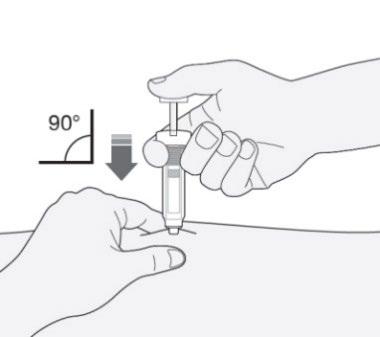
- 3) Press the plunger with your thumb. This will introduce the medicine into the abdominal fatty tissue. Inject the entire amount of medicine from the syringe.
- 4) Remove the needle from the injection site, pulling it straight out. The protective cover will automatically cover the needle. Now you can release the skin fold.
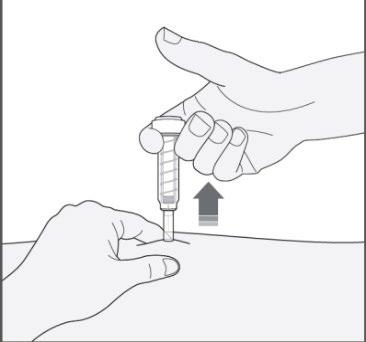
After the injection
- 1) To avoid bruising, do not rub the injection site after the injection.
- 2) Dispose of the used syringe in a container for medical waste. Close the container and store it in a place that is not visible and inaccessible to children. If the container is full, dispose of it according to the doctor's or pharmacist's instructions.
Dispose of any unused medicines or waste in accordance with local regulations.
(Instructions for pre-filled syringes with a safety system of the PREVENTIS type)
Preparing the injection site
- 1) Choose an injection site on the right or left side of the abdomen. The injection site should be at least 5 cm away from the navel towards the sides.
- Do not inject within 5 cm of the navel or around existing scars or bruises.
- Change the injection sites between the left and right side of the abdomen, depending on the location of the previous injection.
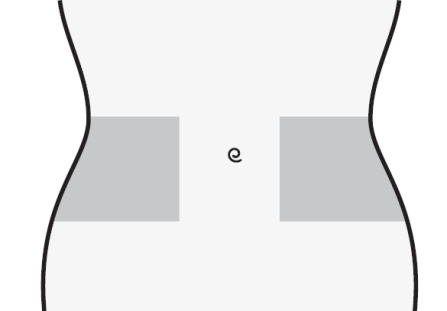
- 2) Wash your hands. Clean the injection site with an alcohol swab or soap and water.
- 3) Sit or lie down in a comfortable position, so that you are relaxed. Make sure the injection site is in your line of sight. A chair, couch, or bed with pillows for support will be suitable.
Dose selection
- 1) Carefully remove the needle cap from the syringe. Discard the cap.
- Do not press the plunger before injecting to remove air bubbles. This may reduce the administered dose.
- After removing the cap, do not touch the needle. This will ensure the sterility of the needle.
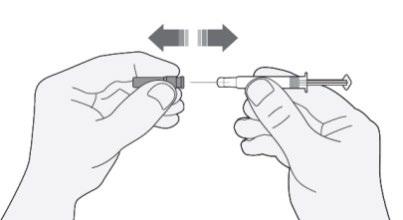
- 2) If the amount of medicine in the syringe is consistent with the prescribed dose, there is no need to adjust the dose. You can now perform the injection.
- 3) If the dose depends on body weight, it may be necessary to adjust the dose in the syringe according to the prescribed dose. In this case, remove excess medicine by holding the syringe upside down (to maintain air bubbles in the syringe) and discard excess medicine into a container.
- 4) A drop may appear at the end of the needle. In this case, remove the drop before injecting by tapping the syringe with the needle facing down. You can now perform the injection.
Injection
- 1) Hold the syringe in the hand you write with (like a pencil). With your other hand, gently grasp the cleaned abdominal skin with your index finger and thumb, creating a skin fold between your fingers.
- Make sure to maintain the skin fold during the injection.
- 2) Hold the syringe with the needle facing down (vertically at a 90-degree angle). Insert the entire length of the needle into the skin fold.
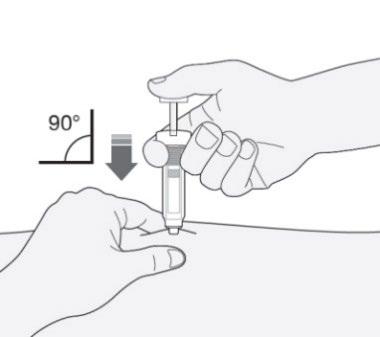
- 3) Press the plunger with your thumb. This will introduce the medicine into the abdominal fatty tissue. Inject the entire amount of medicine from the syringe.
- 4) Remove the needle from the injection site, pulling it straight out while keeping your fingers on the plunger. Hold the needle away from yourself and others, then firmly press the plunger to activate the safety system. The protective cover will automatically cover the needle. A audible "click" will confirm the activation of the protective cover. Now you can release the skin fold.
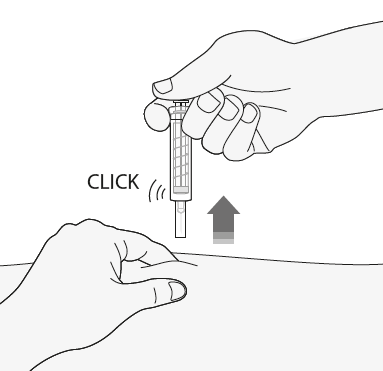
After the injection
- 1) To avoid bruising, do not rub the injection site after the injection.
- 2) Dispose of the used syringe in a container for medical waste. Close the container and store it in a place that is not visible and inaccessible to children. If the container is full, dispose of it according to the doctor's or pharmacist's instructions. Dispose of any unused medicines or waste in accordance with local regulations.
Change of anticoagulant medicine
- Change from Clexane to medicines that thin the blood, called vitamin K antagonists (such as warfarin)The doctor will recommend that the patient undergo blood tests to determine the INR ratio and inform the patient when to stop taking Clexane.
- Change from vitamin K antagonists (such as warfarin) to ClexaneStop taking the vitamin K antagonist. The doctor will recommend that the patient undergo blood tests to determine the INR ratio and inform the patient when to start taking Clexane.
- Change from Clexane to direct oral anticoagulantsStop taking Clexane. Then start taking the direct oral anticoagulant 0 to 2 hours before the scheduled time of the next injection; and then continue taking the medicine as usual.
- Change from direct oral anticoagulant to ClexaneStop taking the direct oral anticoagulant. Clexane treatment can be started only after 12 hours from the last dose of the direct oral anticoagulant.
Use of a higher dose of Clexane than recommended
If the patient thinks they have used too much or too little Clexane, they should immediately inform their doctor, pharmacist, or nurse, even if they do not notice any problems. In case of accidental injection or ingestion of Clexane by a child, immediately go to the hospital emergency department.
Missing a dose of Clexane
If a dose is missed, take it as soon as possible. Do not take a double dose to make up for the missed dose. Keeping a diary helps to ensure that no dose is missed.
Stopping Clexane treatment
It is important to continue injecting Clexane until the doctor recommends stopping it. If treatment is stopped, a blood clot may form, which can be very dangerous.
If you have any further questions about using this medicine, ask your doctor, pharmacist, or nurse.
4. Possible side effects
Like all medicines, Clexane can cause side effects, although not everybody gets them.
Severe side effects
Stop using Clexane and consult your doctor or
nurse immediatelyif you experience symptoms of a severe allergic reaction (such as rash, difficulty breathing or swallowing, swelling of the face, lips, tongue, mouth, throat, or eyes).
If you experience any of the following symptoms, stop using enoxaparin and seek medical attention immediately:
- Red, scaly, widespread rash with thickening under the skin and blisters, accompanied by fever. Symptoms usually appear at the beginning of treatment (acute generalized exanthematous pustulosis).
Like other similar medicines (used to reduce blood clotting), Clexane can cause bleeding. This can be life-threatening. In some cases, bleeding may not be immediately visible.
Consult your doctor immediately if:
- the patient experiences any bleeding that does not stop on its own
- the patient has signs of excessive bleeding such as weakness, fatigue, paleness, dizziness with headaches, or swelling of unknown origin. The doctor may decide to monitor the patient more closely or change the medicine.
Consult your doctor immediately:
- if the patient experiences any signs of a blood clot, such as: crampy pain, redness, increased warmth, or swelling in one of the lower limbs - these are symptoms of deep vein thrombosis, shortness of breath, chest pain, fainting, or coughing up blood - these are symptoms of pulmonary embolism
- if the patient experiences a painful rash or dark red spots under the skin that do not disappear when pressed. The doctor may order blood tests to check the platelet count.
Other side effects:
Very common(may affect more than 1 in 10 people):
- bleeding
- increased liver enzyme activity.
Common(may affect up to 1 in 10 people):
- increased tendency to bruise - this may be due to a decrease in platelet count
- pink spots on the skin - these changes are more likely at the Clexane injection sites
- skin rash (hives)
- itching, red skin
- bruising or pain at the injection site
- decreased red blood cell count
- increased platelet count
- headaches.
Uncommon(may affect up to 1 in 100 people):
- sudden severe headache - this may be a sign of bleeding into the brain
- feeling of tenderness and swelling in the stomach - this may be a sign of bleeding into the stomach.
- large, red skin changes with an irregular shape, with or without blisters
- skin irritation (local irritation)
- the patient may notice yellowing of the skin or eyes and darker urine. This may indicate liver disease.
Rare(may affect up to 1 in 1000 people):
- severe allergic reaction - symptoms of such a reaction may include: rash, difficulty swallowing or breathing, swelling of the lips, face, throat, or tongue
- increased potassium level in the blood - this is more likely in people with kidney disease or diabetes. The doctor can check this with a blood test
- increased eosinophil count in the blood - the doctor can check this with a blood test
- hair loss
- osteoporosis (a condition in which bones are more prone to fractures) after long-term use of the medicine
- tingling, numbness, and weakness of the muscles (especially in the lower part of the body) after a lumbar puncture or spinal or epidural anesthesia
- loss of control over the bladder or bowel (a condition in which the patient is unable to control when they need to go to the toilet)
- hardening or a lump at the injection site.
Reporting side effects
If you experience any side effects, including those not listed in this leaflet, tell your doctor, pharmacist, or nurse. Side effects can be reported directly to the Department of Adverse Reaction Monitoring of Medicinal Products, Medical Devices, and Biocidal Products, Al. Jerozolimskie 181C, 02-222 Warsaw.
Phone: +48 22 49 21 301, fax: +48 22 49 21 309, website: https://smz.ezdrowie.gov.pl
Side effects can also be reported to the marketing authorization holder or its representative in Poland.
Reporting side effects will help to gather more information on the safety of this medicine.
5. How to store Clexane
Do not store above 25°C. Do not freeze.
Store the medicine in a place that is not visible and inaccessible to children.
Do not use this medicine after the expiration date stated on the packaging. The expiration date refers to the last day of the specified month.
Do not use this medicine if you notice that the syringe is cracked, there are solid particles in the solution, or the solution has an unusual color (see "What Clexane looks like and what the pack contains").
Medicines should not be disposed of via wastewater or household waste. Ask your pharmacist how to dispose of medicines that are no longer needed. This will help protect the environment.
6. Contents of the pack and other information
What Clexane contains
- The active substance of Clexane is enoxaparin sodium.
- Each ml contains 100 mg of enoxaparin sodium, which corresponds to 10,000 IU of anti-Xa activity. Each pre-filled syringe of 0.2 ml contains 2000 IU (20 mg) of enoxaparin sodium. Each pre-filled syringe of 0.4 ml contains 4000 IU (40 mg) of enoxaparin sodium. Each pre-filled syringe of 0.6 ml contains 6000 IU (60 mg) of enoxaparin sodium. Each pre-filled syringe of 0.8 ml contains 8000 IU (80 mg) of enoxaparin sodium. Each pre-filled syringe of 1 ml contains 10,000 IU (100 mg) of enoxaparin sodium.
- The other ingredient is: water for injections.
What Clexane looks like and what the pack contains
Clexane is a clear, colorless or yellowish solution for injection in a glass pre-filled syringe (with or without an automatic safety system).
Pack sizes: 2, 5, 6, 10, 12, 20, 24, 30, 50, 100 pre-filled syringes and in bulk packs of 3 x 10, 9 x 10, 100 x 10, and 200 x 10 pre-filled syringes.
Not all pack sizes may be marketed.
Marketing authorization holder
Sanofi Winthrop Industrie
82, Avenue Raspail
94250 Gentilly
France
Manufacturer
Sanofi Winthrop Industrie
Boulevard Industriel, zone industrielle
76580 Le Trait
France
Sanofi Winthrop Industrie
180, rue Jean Jaurès
94 700 Maisons-Alfort
France
CHINOIN Pharmaceutical and Chemical Works Private Co. Ltd.
Csanyikvölgy Site
Miszkolc, Csanyikvölgy
H-3510
Hungary
Sanofi-Aventis Private Co. Ltd
Budapest Logistics and Distribution Platform
Bdg. DC5, Campona utca1.
Budapest, 1225
Hungary
Sanofi-Aventis GmbH
Turm A, 29. OG, Wienerbergstraße 11
1100 Vienna
Austria
Sanofi-Aventis Deutschland GmbH
Industriepark Höchst-Brüningstraße 50
65926 Frankfurt am Main
Germany
To obtain more detailed information on the medicine and its names in the Member States of the European Economic Area, contact the representative of the marketing authorization holder in Poland:
Sanofi Sp. z o.o.
ul. Marcina Kasprzaka 6
01-211 Warsaw
phone: +48 22 280 00 00
Date of last revision of the leaflet:
Other sources of information
Detailed information about this medicine is available on the website of the Office for Registration of Medicinal Products, Medical Devices, and Biocidal Products (www.urpl.gov.pl)
- Country of registration
- Active substance
- Prescription requiredYes
- Manufacturer
- ImporterChinoin Pharmaceutical and Chemical Works Private Co. Ltd. - Csanyikvolgy Site Sanofi Winthrop Industrie Sanofi Winthrop Industrie Sanofi-Aventis Deutschland GmbH Sanofi-Aventis GmbH Sanofi-Aventis Private Co. Ltd.
- This information is for reference only and does not constitute medical advice. Always consult a licensed doctor before taking any medication. Oladoctor is not responsible for medical decisions based on this content.
- Alternatives to ClexaneDosage form: Solution, 12,000 IU (120 mg)/0.8 mlActive substance: enoxaparinPrescription requiredDosage form: Solution, 15,000 IU (150 mg)/mlActive substance: enoxaparinPrescription requiredDosage form: Solution, 4000 IU (40 mg)/0.4 mlActive substance: enoxaparin
Alternatives to Clexane in other countries
The best alternatives with the same active ingredient and therapeutic effect.
Alternative to Clexane in Hiszpania
Alternative to Clexane in Ukraina
Online doctors for Clexane
Discuss dosage, side effects, interactions, contraindications, and prescription renewal for Clexane – subject to medical assessment and local rules.














